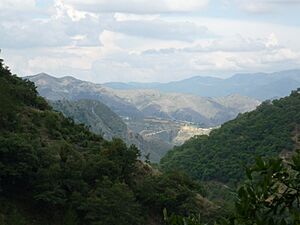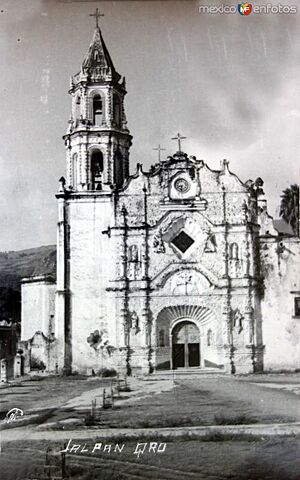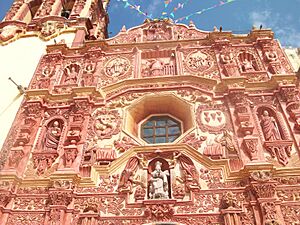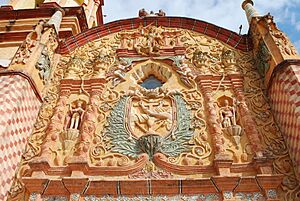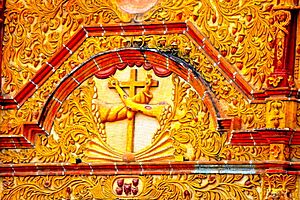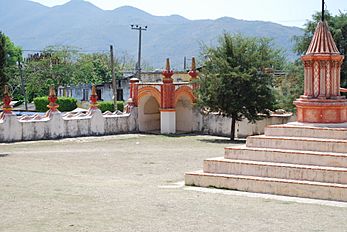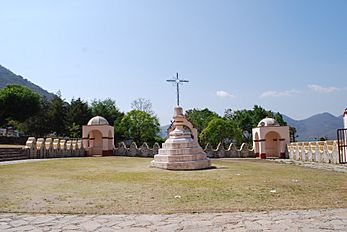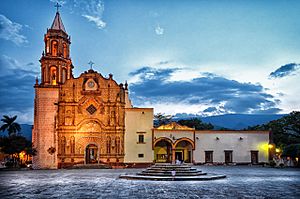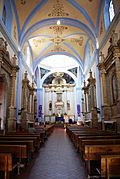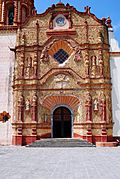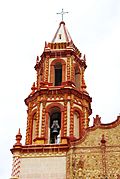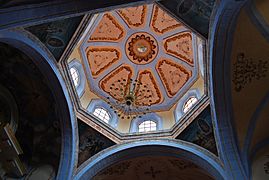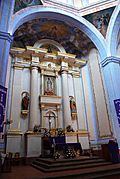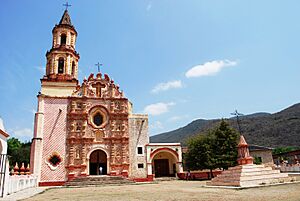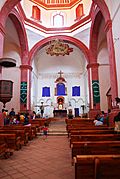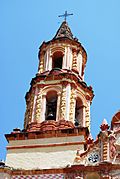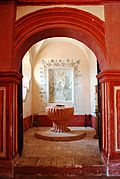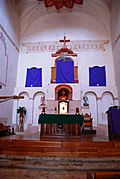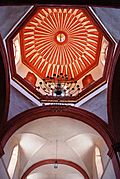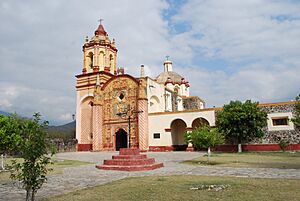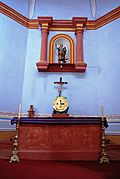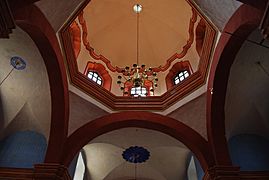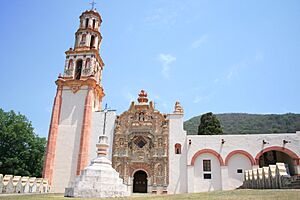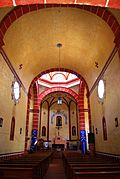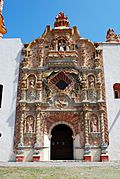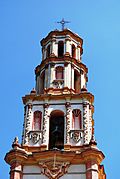Franciscan Missions in the Sierra Gorda of Querétaro facts for kids
Quick facts for kids Franciscan Missions in the Sierra Gorda of Querétaro |
|
|---|---|

Mission At Santiago de Jalpan
|
|
| Location | Sierra Gorda, Querétaro, Mexico |
| Built | Between 1750 and 1760 |
| Built for | Franciscan Order |
| Restored | 1990s |
| Official name: Franciscan Missions in the Sierra Gorda of Querétaro | |
| Type | Cultural |
| Criteria | ii, iii |
| Designated | 2003 (27th session) |
| Reference no. | 1079 |
| Region | Latin America and the Caribbean |
| Lua error in Module:Location_map at line 420: attempt to index field 'wikibase' (a nil value). | |
The Franciscan missions of the Sierra Gorda of Querétaro are five old churches built in Mexico. They were constructed between 1750 and 1760. A famous friar named Junípero Serra helped start these missions. He also built many important missions in California.
These missions are special because of their unique style. They mix European and local art. In 2003, UNESCO named them a World Heritage Site. This means they are important for everyone in the world to protect. They show how different cultures came together during the time of colonization in Mexico.
Contents
The Sierra Gorda Region
The Sierra Gorda is a beautiful mountain area in Mexico. It is mostly in the state of Querétaro. This region is part of a larger mountain range called the Sierra Madre Oriental. It has many steep mountains and deep canyons.
The Sierra Gorda has many different environments. You can find tall forests with pine trees on mountain tops. In the deep canyons, there are fields of bananas and sugar cane. Some parts are like deserts with lots of cacti. This mix of high and low places, with different amounts of rain, means many kinds of plants and animals live here.
Building the Missions
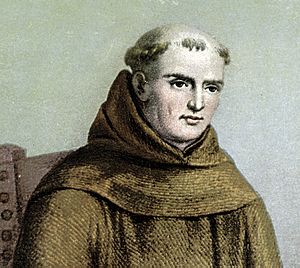
The mission in Jalpan was started in 1750. This was even before Junípero Serra arrived. But Serra is known for building the five main missions. He also helped teach the local people about Christianity.
The missions were mostly built by the Pame people. They worked under the guidance of Franciscan friars. These friars included José Antonio de Murguía, Juan Crispi, Juan Ramos de Lora, and Miguel de la Campa de Landa.
Serra had a special idea for these missions. He wanted to create a peaceful community based on Franciscan beliefs. He worked to understand the Pame people's problems and even learned their language. Serra helped them form groups to work together. He also encouraged them to share land. His work had a big impact on the people. The unique art you see in the missions today shows this mix of cultures.
History of the Missions
Long ago, before the Spanish arrived, there were cities in this area. But these cities were empty by the 1500s. When the Spanish came, the native people were nomadic hunter-gatherers. These included the Pames, Ximpeces, Guachichils, and Jonaz. They were often called the Chichimecas.
The Spanish found it hard to control the central Sierra Gorda. This was because of the rough mountains and strong resistance from the native people. Many early attempts to build missions failed. The native communities often destroyed them. For example, the Bucareli Mission was started in 1797 but was never finished. It was abandoned during the Mexican Revolution.
In the 1740s, the Spanish government decided to take full control of the area. This was to protect trade routes. José de Escandón led a military effort that defeated the Jonaz and Ximpeces. After this, it was safer to build permanent missions. The five Franciscan missions were built in Pame territory. The Pame people were more open to Spanish rule. The Spanish moved Pame villages to be closer to the missions. This helped them control the area better.
Junípero Serra worked on the missions for eight years. But in 1770, the missions were left empty. Serra then moved to California. For many years, the mission buildings were neglected and damaged. This was especially true during the Mexican Revolution. Many churches were looted, and statues on the mission facades were broken.
In the 1980s, some people from a Mexican history group (INAH) found one of the lost missions. This discovery led to efforts to save them. Restoration work began in the 1980s. Between 1991 and 1997, the insides of the churches were repaired. More work was done until 2002 on the surrounding areas. In 2003, the missions were finally named a World Heritage Site. Today, you can visit them on a special "Mission Route."
Mission Architecture
The main thing that makes these churches special is the beautiful art on their main entrances. This style is called "New Spanish Baroque" or "mestizo Baroque." The art was meant to teach the native people about the new religion. But it also clearly shows native influences. Junípero Serra wanted the art to show a mix of cultures, not just a takeover.
You can see this mix in the colors used, like red, orange, and yellow. Also, there are sacred native animals, like the rabbit and the jaguar. Each church has one main room, covered by a rounded ceiling. But each mission also has its own unique features, especially on the front doors.
The Sierra Gorda missions have special designs for their layouts and heights. Their facades (fronts) have very original decorations. These are made from stucco, which is like plaster, colored with earth. Even though these missions were built in the 1700s, they still use some basic ideas from older church designs of the 1500s.
Capilla Posa: Unique Outdoor Chapels
The missions also have something called a Capilla posa. These are small, square buildings with arched roofs. They are found at the corners of the main courtyard outside the church. These chapels are a unique part of Spanish-American colonial art. They were likely used during religious parades. People would stop or "pose" the Blessed Sacrament in them as they walked around the courtyard.
-
Habsburg double headed eagle on the facade of the Concá mission
-
Capilla posa at the Mission of Nuestra Señora de la Luz de Tancoyol
The Five Missions
Santiago de Jalpan Mission
The Santiago de Jalpan mission was the first to be built by Junípero Serra. It was finished between 1751 and 1758. It is dedicated to Saint James the Greater. This mission is in the center of the town of Jalpan. It has a courtyard, a cloister (a covered walkway), a pilgrim's entrance, and the church itself.
The front of the church is very detailed. It has images of Our Lady of the Pillar and the Virgin of Guadalupe. These are important figures in Mexico and Spain. You can also see a double-headed eagle, which shows the mix of two cultures. The decorations are made of stucco and stone. They use colors like yellow and orange. You can see plants, small angels, and eagles. There are also statues of saints like Saint Dominic and Francis of Assisi. Inside, the dome has scenes of the Virgin of Guadalupe.
Nuestra Señora de la Luz de Tancoyol Mission
The Nuestra Señora de la Luz de Tancoyol mission is dedicated to Our Lady of Light. Its front is covered in many plant decorations, especially corn. It is the most detailed of all five missions. Juan Ramos de Lora likely built this mission.
The church has a cross shape inside. It has a sacristy (a room for priests) and a courtyard with a cross. There are also the special corner chapels called "capillas posas." The main idea of the front decoration is mercy. It shows the Virgin Mary and different saints. The art here is the most complex of all the missions. You can see images of Saints Peter and Paul. There are also symbols of the Passion, like nails and a spear. The bell tower is tall and thin.
San Miguel Concá Mission
The San Miguel Concá mission is about 40 km from Jalpan. It is dedicated to the Archangel Michael. This is the smallest of the mission churches. It was probably finished in 1754. The name Concá means "with me" in the Pame language.
The decorations on this mission have large flowers, leaves, and figures in a native style. It is special because it has an image of the Holy Trinity at the very top. You can also see a rabbit, which is a Pame symbol, and a double-headed eagle.
San Francisco de Asís del Valle de Tilaco Mission
The San Francisco de Asís del Valle de Tilaco mission is in a small community. Juan Crespi built it between 1754 and 1762. It is dedicated to Francis of Assisi. This mission is built on a slope. Its bell tower is separate from the main church. It also helps support the church building.
Tilaco is the best-preserved of the five missions. Its decorations are more subtle. The front has small angels, corn, and a large jar. Above this is an image of Francis of Assisi. A unique decoration here is four mermaids with native faces. Tilaco also has the best-preserved "capillas posas" in its courtyard.
Santa María de la Purísima Concepción del Agua de Landa Mission
The Santa María de la Purísima Concepción del Agua de Landa mission was built between 1760 and 1768 by Miguel de la Campa. It is dedicated to Our Lady of the Immaculate Conception. This was the last mission to be built.
The mission has a wall around its courtyard with a cross in the middle. It is known for its balanced design and a very narrow bell tower that is part of the front of the church. Many people think the sculptures on this mission's facade are the best of all five. The faces of the mermaids at Landa also have native features.
Inside, you can see medallions on the ceiling. These show Archangel Michael and other important figures. The Franciscan friars left their mark here, showing their beliefs through art.
See also
 In Spanish: Misiones franciscanas de la Sierra Gorda de Querétaro para niños
In Spanish: Misiones franciscanas de la Sierra Gorda de Querétaro para niños
- Mendicant monasteries in Mexico
- Spanish missions in Mexico


